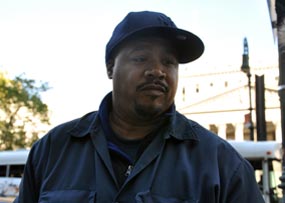Thousands of demonstrators took to the streets of lower Manhattan Wednesday to speak out against issues including bank bailouts, tax cuts for the wealthy, and economic conditions that have resulted in joblessness, lower wages and more. The movement, sparked by the hundreds of mostly young protesters who’ve camped out in recent weeks in lower Manhattan’s Zuccotti Park, had its biggest showing yet in part from the support of major labor unions and other political advocacy and social justice groups. An Occupy Wall Street spokesman estimated the number of demonstrators to be 10,000.

Zuccotti Park on Wednesday evening
“I’m full of joy that we found each other,” Lillian Roberts, executive director of DC 37, a union representing 125,000 New York City public employees, told the throng of protesters gathered in and around Manhattan’s Foley Square before they began their march toward Wall Street. “The middle class is too big to fail,” read a sign jutting above the crowd, one of many expressing discontent with the current economic climate.
The movement is decentralized and consensus-driven, an open space to air concerns and share ideas; critics have suggested the movement’s aims are not narrowly defined. Supporters have come to be known as “99 percenters,” a reference to those who aren’t among the wealthiest one percent of Americans that control 40 percent of the nation’s wealth, according to Think Progress. In recent days, the movement has spread nationwide, with protests happening in cities from coast to coast.
[Related Article: As Occupy Wall Street Grows, Scope of Grievances is Great]
“We represent workers and workers are getting beat up,” said demonstrator Carlos Trinidad, hospital contract administrator and 1199SEIU member, when asked on Wednesday why he decided to lend the movement his support. “The cost of living has exceeded workers wages already.”
All industries have been affected by the choked economy, he says, and the hospitals represented by his union, which represents 300,000 members and retirees in New York, New Jersey, Maryland, the District of Columbia, Florida and Massachusetts, are no exception. Hospital bankruptcies and closings, like that of St. Vincent’s in Greenwich Village, have been of particular concern.
“This isn’t happening to the big-time hospitals,” he says. “It’s happening to the community-based hospitals.”
Likewise, Anne D. Perryman, whose organization, the Association of Tenants of Lincoln Towers, represents tenants of 500 rent-stabilized apartments in the complex on Manhattan’s upper west side, found common cause with the voiced discontent.
“You cannot separate affordable housing in the city with what’s going on economically,” she says. “We are activists in the tenants’ rights movement that represent rent-stabilized apartments that have felt the pain of greedy developers taking over rent-stabilized buildings.” According to Perryman, there are a million such apartments in New York City.
[Resource: Get your free Credit Report Card]

Lamar Anderton
Bus maintenance worker and TWU Local 100 member Lamar Anderton said he joined demonstrators to protest job cuts, to support unionized Verizon workers, “and to come together with union strength of course.” he says. Earlier in the week, the transportation workers union asked the New York State Supreme Court to grant a restraining order to prevent “forced use” of union bus drivers to transport arrested protesters. At least five MTA buses were used for this purpose after more than 700 protesters were arrested for marching onto the Brooklyn Bridge, Gothamist reports. “If we wanted to be police, we would have taken that job,” said Tom Lenane, a union representative of 23 years. According to The New York Times, 23 people were arrested at Wednesday’s demonstration, most of them charged with disorderly conduct.
Steve Falla Riff, an employee of The Legal Aid Society and member of the Association of Legal Aid Attorneys, UAW 2325, AFL-CIO, said he believed in the march “at an elemental level, about the right to assemble.” A legal observer for the movement on its first day, Falla Riff called Wednesday’s demonstration “an exercise in constitutional rights, which are often theoretical and not real.” It’s an exercise that has succeeded in capturing White House attention—on Thursday President Obama said the Occupy Wall Street protests reflect a “broad-based frustration about how our financial system works, according to CBS News. The president also “pledged to continue fighting to protect American consumers,” according to CBS News.
“The overarching issue is that people are losing their homes. It’s not fine policy points,” said Freddie Carter, who traveled to lower Manhattan with fellow congregants from St. Mary’s Episcopal Church in Harlem. “The politicians are working for the corporations,” added Zooey Park, who said he was inspired to attend the protests after he’d heard of the Brooklyn Bridge police incident. Carter said she’d heard criticisms that Occupy Wall Street was too unfocused in its aims, but having protested the Vietnam War as a high school student, she could say the same of demonstrations back then.
After the march and into the evening, one Zuccotti Park activist, who identified herself as Evelyne, shared concerns about the nation’s vast wealth disparities, high unemployment rates, and debt. “America needs to stand up for what it means,” she said. “We go to other countries trying to expose human rights violations. We need to lead by example.”
[Featured Product: Need credit monitoring options?]
You Might Also Like
March 11, 2021
Personal Finance
March 1, 2021
Personal Finance
February 18, 2021
Personal Finance





